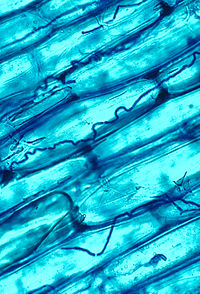
Photo from wikipedia
Simple Summary Arbuscular mycorrhizal fungi can be used as a potential alternative to chemical pesticides for pest control. In this study, two mycorrhizal fungi (Glomus mossae and Glomus intraradices), P.… Click to show full abstract
Simple Summary Arbuscular mycorrhizal fungi can be used as a potential alternative to chemical pesticides for pest control. In this study, two mycorrhizal fungi (Glomus mossae and Glomus intraradices), P. alba × P. berolinensis seedlings, and gypsy moth larvae were successfully used to investigate the basis of mycorrhiza-induced resistance/susceptibility at the larval microbial and metabolic levels. The disadaptation of gypsy moth larvae to the leaves of GM-colonized seedlings, such as the gut microbial dysfunction and fat body metabolic disorder, is the main reason for GM-induced insect resistance. However, the improvement of gut environment and fat body metabolism in gypsy moth larvae results in the GI-induced insect susceptibility. Abstract Arbuscular mycorrhizal fungi (AMF) are considered as important biological factors that can affect insect resistance of plants. Herein, we used AMF-poplar seedlings that could either increase or decrease the resistance to gypsy moth larvae, to elucidate the mechanism of mycorrhizal-induced insect resistance/susceptibility at the larval microbial and metabolic levels. Our results found that larval plant consumption and growth were significantly inhibited in the Glomus mossae (GM)-colonized seedlings, whereas they were enhanced in the Glomus intraradices (GI)-colonized seedlings. GM inoculation reduced the beneficial bacteria abundance in the larval gut and inhibited the detoxification and metabolic functions of gut microbiota. However, GI inoculation improved the larval gut environment by decreasing the pathogenic bacteria and activating specific metabolic pathways. Furthermore, GM inoculation triggers a metabolic disorder in the larval fat body, accompanied by the suppression of detoxification and energy production pathways. The levels of differentially accumulated metabolites related to amino acid synthesis and metabolism and exogenous toxin metabolism pathways were significantly increased in the GI group. Taken together, the disadaptation of gypsy moth larvae to leaves of GM-colonized seedlings led to the GM-induced insect resistance in poplar, and to the GI-induced insect susceptibility involved in the improvement of larval gut environment and fat body energy metabolism.
Journal Title: Insects
Year Published: 2022
Link to full text (if available)
Share on Social Media: Sign Up to like & get
recommendations!